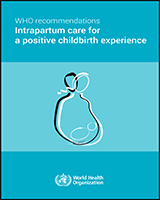This guideline will be available online for download and also as a printed publication. Online versions will be available via the websites of the WHO Departments of Reproductive Health and Research (RHR) and Maternal, Newborn, Child and Adolescent Health (MCA), and through the WHO Reproductive Health Library (RHL).1 Print versions will be distributed to WHO regional and country offices, ministries of health, WHO collaborating centres, NGO partners and professional associations, using the same distribution list that was developed for the antenatal care guideline: WHO recommendations on antenatal care for a positive pregnancy experience (35). This guideline will be accompanied by an independent critical appraisal based on the AGREE instrument (Appraisal of Guidelines for Research & Evaluation) (199). Technical meetings will be held within the WHO RHR and MCA Departments to share the recommendations and derivative products, which will include a practical manual for implementation of the new WHO intrapartum care model, with the teams responsible for policy and programme implementation.
Two sets of evidence briefs will be developed: one set for policy-makers and programme managers and the other set for health care professionals. These evidence briefs, which will highlight the recommendations and implementation-related contextual issues, will be developed and disseminated in collaboration with USAID, FIGO and ICM.
The executive summary and recommendations from this publication will be translated into the six UN languages for dissemination through the WHO regional and country offices and during meetings organized by, or attended by, staff of the WHO RHR and MCA Departments.
In addition to online and print versions of this guideline, an interactive web-based version is planned, which will be developed by a professional content communication and design firm that specializes in infographics. This will facilitate the dissemination and uptake of the guideline recommendations by making them available online in a user-friendly format, and will allow a platform for cross-referenced recommendations to be updated or added on an ongoing basis to ensure that the recommendations are up to date and comprehensive. Furthermore, this would allow for focused activities and products to be developed. English, French, Portuguese and Spanish (the latter in collaboration with the WHO Regional Office for the Americas/Pan American Health Organization [PAHO]) web-based versions are planned and have been budgeted for.
The guideline will also be launched on the WHO RHR departmental website as part of the monthly HRP News. This site currently has over 4500 subscribers including clinicians, programme managers, policy-makers and health service users from all around the world. In addition, a number of articles presenting the recommendations and key implementation considerations will be published, in compliance with WHO's open access and copyright policies. Relevant WHO clusters, departments and partnerships, such as the Partnership for Maternal, Newborn & Child Health (PMNCH), will also be part of this dissemination process.
In an effort to increase dissemination of WHO guidelines on sexual and reproductive health and rights, a search function with the ability to search the database of WHO guidelines and recommendations has been created and recently launched by the RHR Department.2 The intrapartum care guideline recommendations will be made available via this search function.
The Maternal and Perinatal Health and Preventing Unsafe Abortion team of the RHR Department, in collaboration with the MCA Department and other partners, will support national and subnational working groups to adapt and implement the guideline. This process will include the development or revision of existing national guidelines or protocols in line with the WHO guideline. The GREAT Network (Guideline-driven, Research priorities, Evidence synthesis, Application of evidence, and Transfer of knowledge) will be used to bring together relevant stakeholders to identify and assess the priorities, barriers and facilitators to guideline implementation, and to support the efforts of stakeholders to develop adaptations and guideline implementation strategies tailored to the local context (200). This includes technical support for local guideline implementers in the development of training manuals, flow charts and quality indicators, as well as participation in stakeholder meetings.
- 1
- 2

